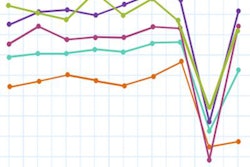
Medicare reimbursements for medical imaging have declined since 2007, and whether payment rates are adequate to match increasing demand for imaging is a pressing question, according to a study published July 22 in the Journal of the American College of Radiology.
The findings are key to a clear understanding of how imaging is currently reimbursed, wrote a team led by Dr. Soryan Kumar of Brown University in Providence, RI.
"Diagnostic imaging has become an integral aspect of preventive medicine as screening as become more prevalent among the general population," the group wrote. "[But] the majority of imaging procedures examined in this investigation from 2007 to 2019 depicted reimbursement decreases, which are exacerbated by increasing demand and supply for diagnostic imaging to aid in the treatment plans of patients. With current inflation rates, increased demand of diagnostic imaging, and changes to health care policy, properly modeling these decreases is crucial to the continued maintenance of radiology practices around the country."
Trends in Medicare reimbursement have been evaluated in some specialties, such as orthopedic surgery and oncology, but not so much for diagnostic radiology, the authors noted. And this kind of information is crucial to the successful management of radiology practices, which require "a broad understanding of cost management and quality, safety improvement, and procedural reimbursement trends" to be successful, they wrote.
For their study, Kumar and colleagues used data from the Centers for Medicare and Medicaid Services (CMS) Physician Fee Schedule Look-Up Tool to evaluate reimbursement rates between 2007 and 2019 across a range of imaging modalities, including bone densitometry, CT, CT angiography (CTA), mammography, MR angiography, MRI, nuclear medicine, radiography, and ultrasound. The team calculated the compound annual growth rate (CAGR), average annual change, and total percentage change in reimbursement, adjusting for inflation to U.S. 2019 dollars. The group did not distinguish between technical and professional reimbursement decreases.
On average, all imaging modalities decreased in total percentage change as well as annual change in reimbursement during the study timeframe. MRI showed the greatest mean decrease in reimbursement rates, while bone densitometry showed the biggest decrease in total percentage change. Nuclear medicine was least affected. The group attributed the changes in part to the Deficit Reduction Act (DRA) of 2006, which reduced the technical component of reimbursement in 2007.
| Medicare reimbursement trends by imaging modality, 2007-2019 | |||
| Modality | Mean compound annual growth rate (CAGR) | Mean annual change | Mean total percentage change |
| Bone densitometry | -9.7% | -$8.24 | -70.5% |
| CT | -4.9% | -$17.66 | -45.1% |
| CTA | -6% | -$38.12 | -52.5% |
| Mammography | -0.6% | -$0.98 | -7.1% |
| MRA | -6.2% | -$39.83 | -53.7% |
| MRI | -8.2% | -$52.08 | -64.1% |
| Nuclear medicine | -0.4% | -$0.32 | -4.3% |
| Radiography | -1.3% | -$0.71 | -14.6% |
| Ultrasound | -2.1% | -$4.13 | -22.9% |
The study findings point to the need for more research on reimbursement trends, according to Kumar and colleagues.
"Further investigation is encouraged to properly model future trends to ensure the sustainability of imaging studies and radiology practices around the country," they concluded.




















